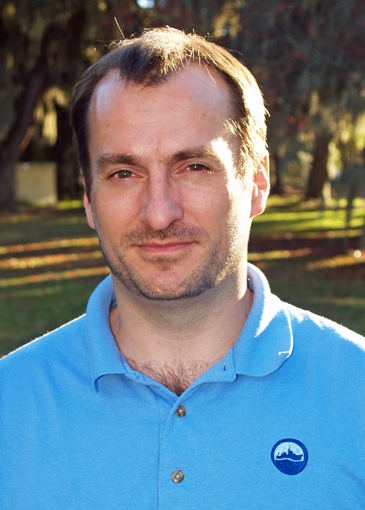Athens, Ga. – From beach shallows to the ocean depths, vast numbers of chemical compounds work together to reduce and store atmospheric carbon in the world’s oceans.
In the past, studying the connections between ocean-borne compounds and microbes has been impractical because of the sheer complexity of each. Three University of Georgia faculty members—along with an international team of scientists—bring to the forefront technological developments that are providing scientists with the analytical tools needed to understand these molecular-level relationships.
Their perspective article appears March 7 in the Proceedings of the National Academy of Sciences. It focuses on dissolved organic matter, or DOM, in the world’s oceans as a central carbon reservoir in the current and future global carbon cycle.

Skidaway Institute’s Aron Stubbins
“Dissolved organic carbon is an amazing and confounding molecular soup,” said Aron Stubbins, co-author and associate professor of marine sciences at UGA housed at the Skidaway Institute of Oceanography in Savannah. “It sits at the center of the ocean carbon cycle, directing the energy flow from the tiny plants of the sea, phytoplankton, to ocean bacteria. Though around a quarter of all the sunlight trapped by plants each year passes through dissolved organic carbon, we know very little about the chemistry of the molecules or the biology of the bacterial players involved.”
The carbon the microbes process is stored in seawater in the form of tens of thousands of different dissolved organic compounds.
Researchers thought they had a handle on how some aspects of the process works, but “a number of new studies have now fundamentally changed our understanding of the ocean carbon cycle,” said the paper’s lead author Mary Ann Moran, Distinguished Research Professor at UGA.
In the context of methodological and technological innovations, the researchers examine several questions that illustrate how new tools—particularly innovations in analytical chemistry, microbiology and informatics—are transforming the field.
From how different major elements have cycles linked though marine dissolved organic matter to how and why refractory organic matter persists for thousands of years in the deep ocean to the number of metabolic pathways necessary for microbial transformation, the article infers a scale of enhanced and expanded understanding of complex processes that was previously impractical.
The perspective article, “Deciphering Ocean Carbon in a Changing World,” was shaped in discussions at a 2014 workshop supported by the Gordon and Betty Moore Foundation and Microsoft Research Corporation. Moran’s research has been supported by the Gordon and Betty Moore Foundation’s Marine Microbiology Initiative.
Co-authors on the paper include UGA’s Patricia Medeiros, assistant professor in the department of marine sciences. Others involved are with the Woods Hole Oceanographic Institute; the Scripps Institute of Oceanography and the Skaggs School of Pharmacy and Pharmaceutical Sciences, University of California, San Diego; University of Tennessee, Knoxville; Oregon State University; Columbia University; The Pacific Northwest National Laboratory, Richland Washington; the University of Washington; University of Oldenburg, Germany; Sorbonne Universités; and the University of Chicago.
Writer: Alan Flurry, 706-542-3331, aflurry@skio.uga.edu
Contacts: Mary Ann Moran, 706-542-6481, mmoran@skio.uga.edu; Patricia Medeiros, 706-542-6744, medeiros@skio.uga.edu; Aron Stubbins, 912-598-2320, aron.stubbins@skio.uga.edu
###
This release is online at http://news.skio.uga.edu/releases/article/molecular-level-relationships-ocean-carbon/.


